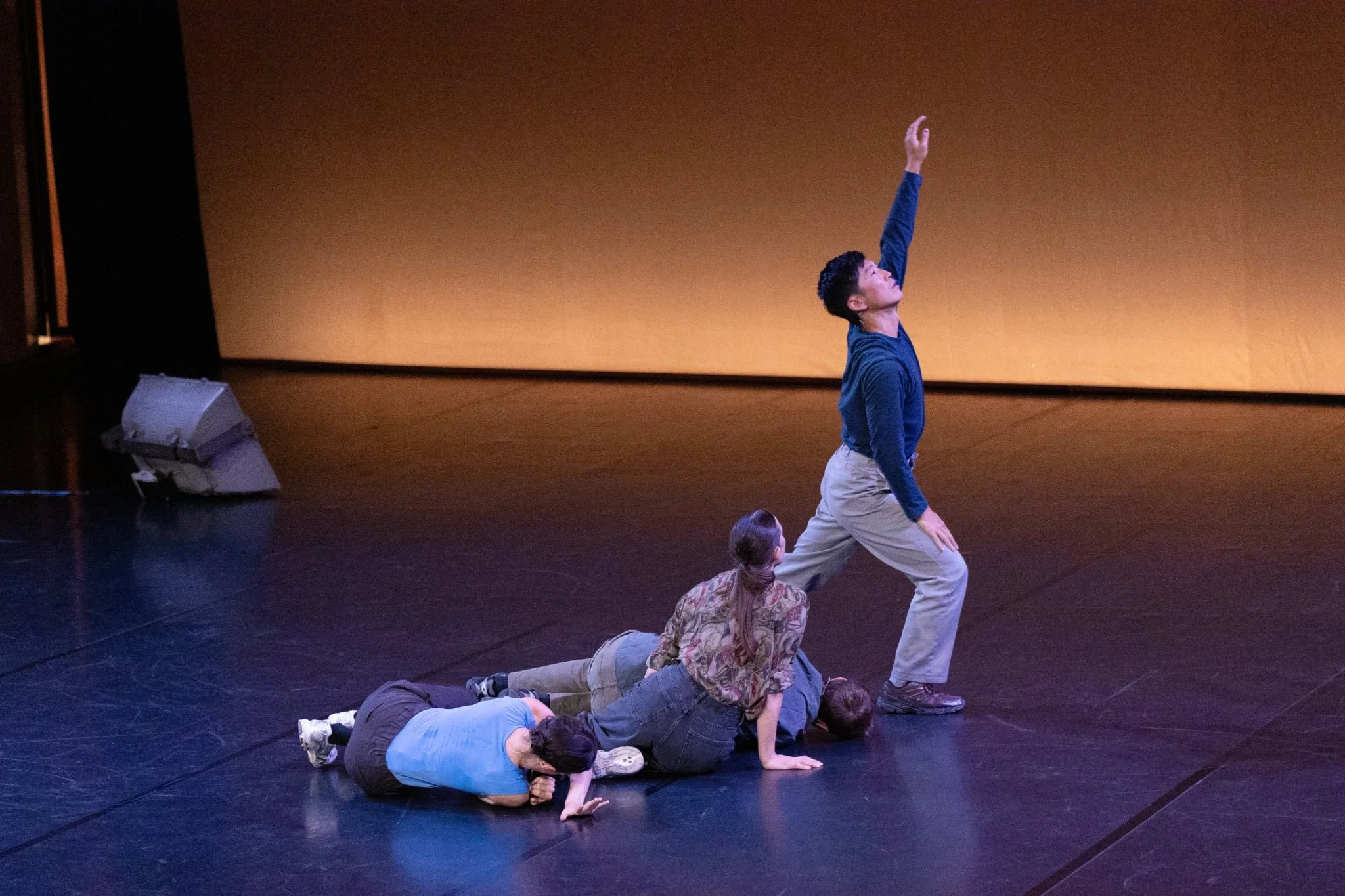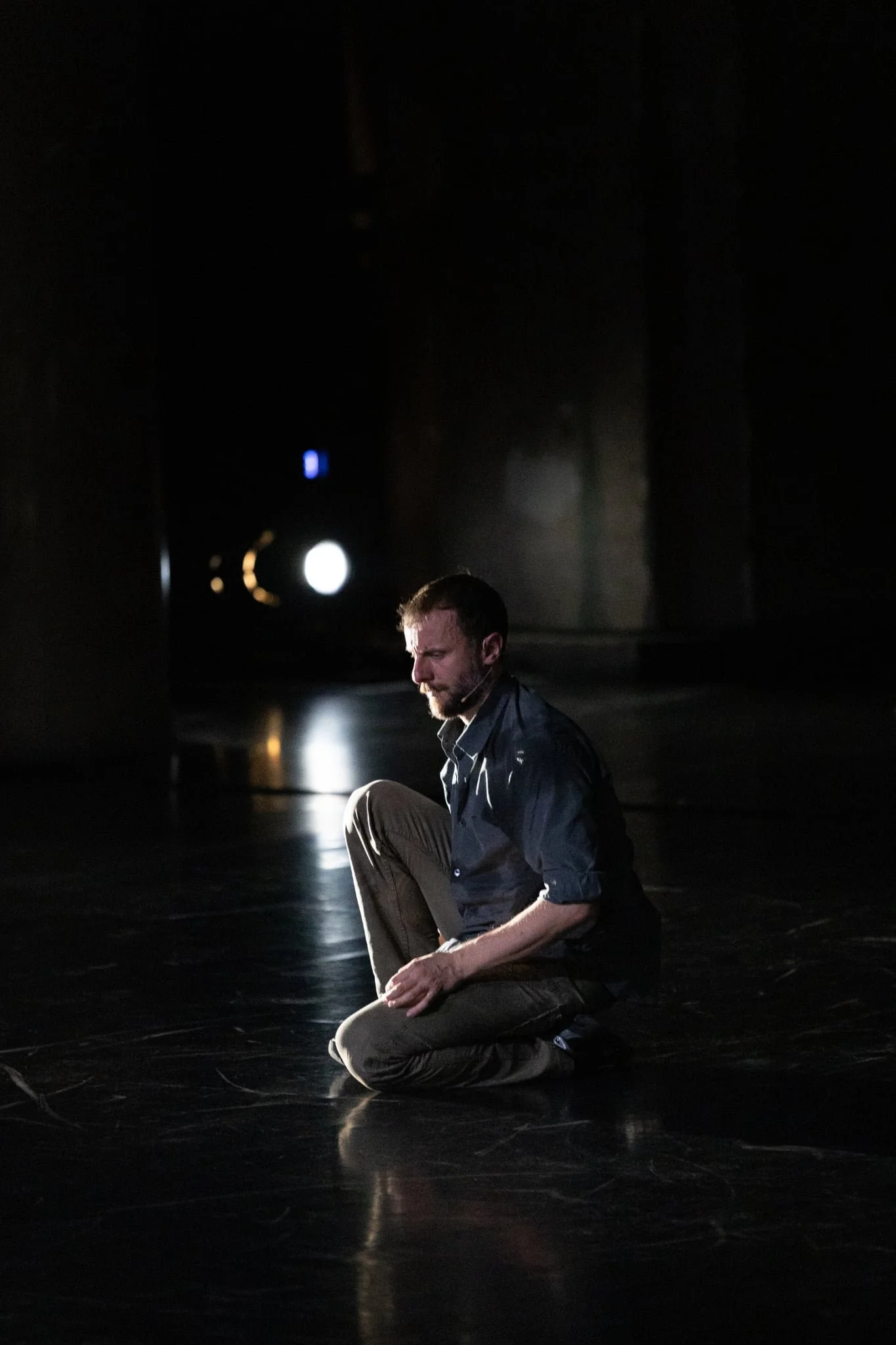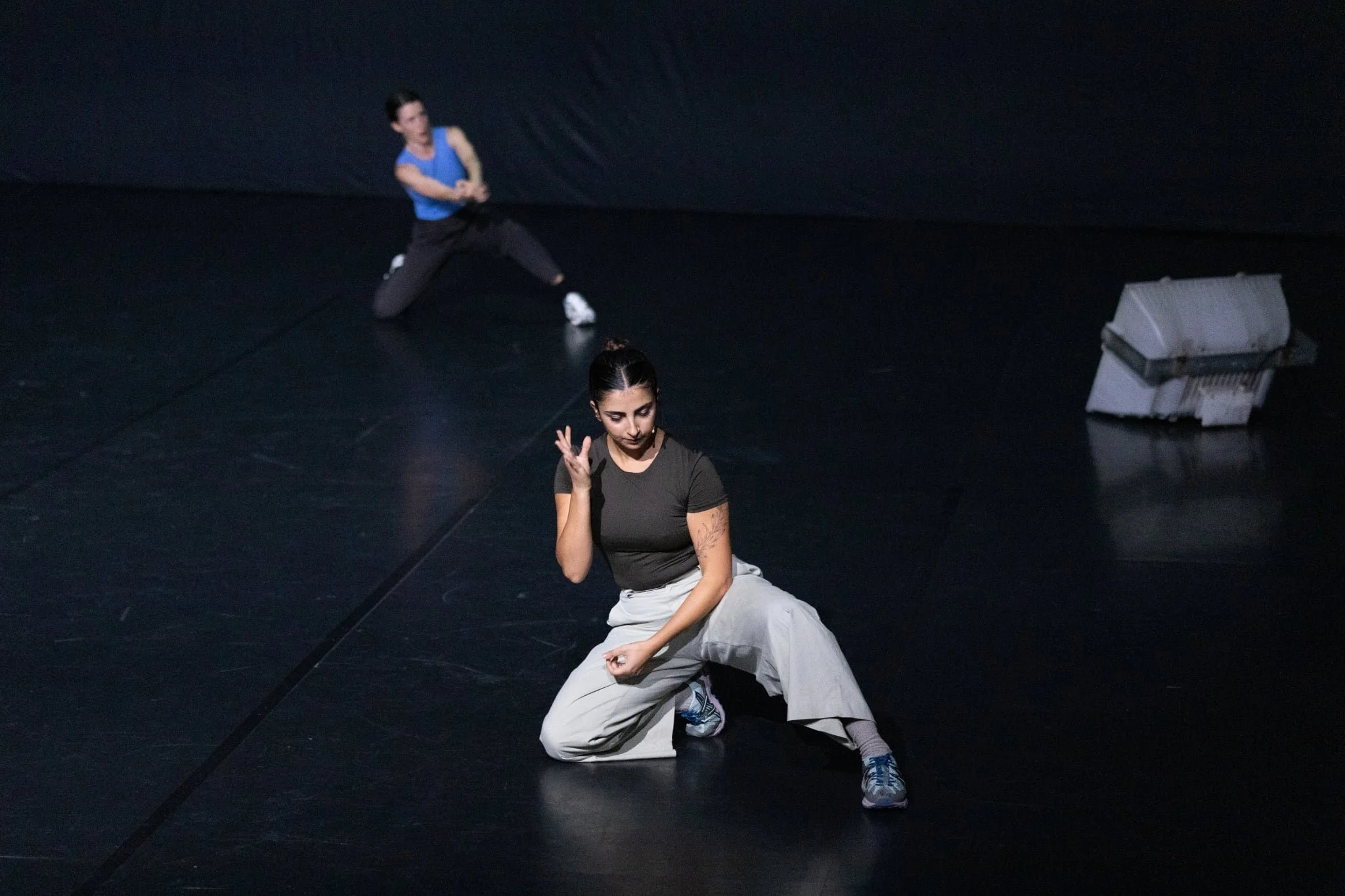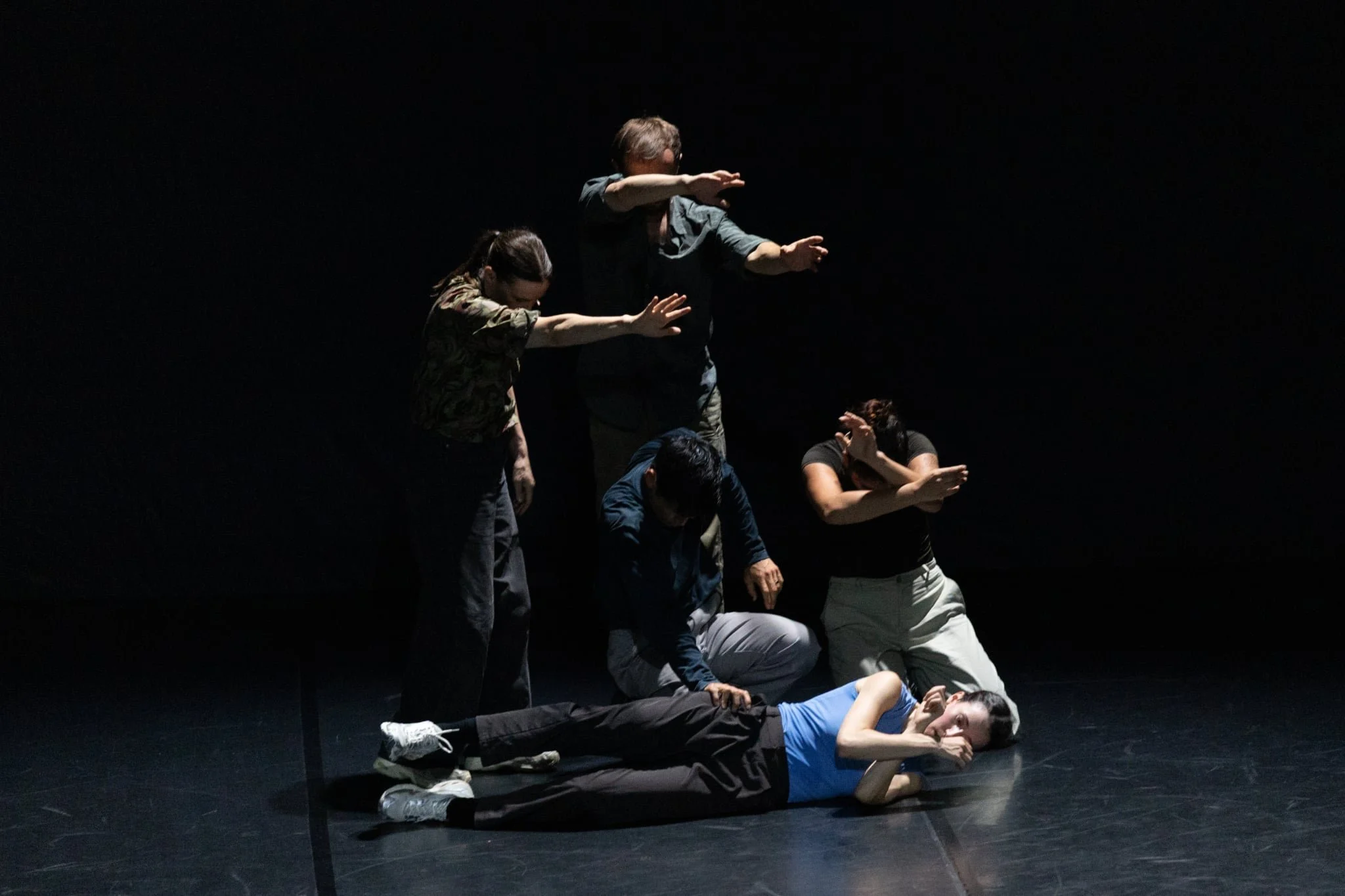Earth Works by Sergiu Matis, at the Vienna Odeon Theater, on July 11, 2025, as part of ImPulsTanz Festival 2025
by Simona Noja-Nebyla
Earth Works is a dance piece by Sergiu Matis, a Romanian choreographer born in Cluj-Napoca and educated in Romania and Germany. Premiered in December 2024 in Berlin, it draws on reflections by authors from different parts of the world, recounting their personal experiences with the threatened environment.
Through words, sentences, and images, the text carries the five performers: Lisa Densem, Moo Kim, Sergiu Matis, Nicola Micallef, and Manon Parent, who, in turn, embody the movements generated by the written and spoken word in space. In this live exchange of knowledge, we, the audience, encounter ancestral essences of cultures (often unfamiliar to most Europeans) and their messages.
Metaphors like “Water is the first story of place” or “A river is the song of running water” echo within us the ancient Greek memory of Thales of Miletus, who believed that everything began with water. There is an immediate connection between us and the Wiradjuri belief (Australia) as “people of the rivers.” We recognize that rivers belong to all of us, that they, like us, want to keep flowing, evolving. Jeanine Leane goes even further: “Rivers are us.” As long as water can flow, there is life—something that should never be stopped or broken. “If a deity is a force that can either create or destroy all life, then water is our highest power. What retribution will the future bring if we fail in our reverence for rivers?” [Leane, J. (2025). Galing-gu giiland. In Earth Works (Performance program, pp. 6–8). Vienna.]
Translated into movement, the dancers know no boundaries of embodiment; they are alive as long as they can move and bring ideas into manifestation. Through their bodies, the dancers let truth flow. If words may abstract meaning, the dancers carry the detailed significance of each thought, delivering it into virgin territories of sense—making it visible, perhaps newly understood, and why not, loved for the first time.
Photo@Boris Nebyla
Wiradjuri poetry is polyphonic; it holds ancestral voices, personal memory, communal trauma, language, resistance—all together, in a layered and powerful way. In a Western literary context, this idea is famously explored by Russian thinker Mikhail Bakhtin, who described the novels of Dostoevsky as “polyphonic”, allowing multiple moral, social, and philosophical voices to speak without the author imposing one “final truth.”
Is polyphony a renewal of the syncretic primordial arts?
Does bringing many voices together in poetry or art revive an older, foundational way of making art—one inherently blended, ritualistic, communal, before divisions like “high” and “low” art or “Western” and “Indigenous” systems?
In the context of Wiradjuri poetry (and many Indigenous poetics), polyphony is not a postmodern innovation; it’s a continuation of ancient practices. Oral traditions have always been multi-voiced: ancestor stories, songlines, past and present intertwined. Colonialism tried to flatten or silence this multiplicity, though poets like Jeanine Leane reclaim and re-weave those many voices—it’s both renewal and resistance.
But polyphony isn’t always syncretic in the sense of blending traditions into one. Sometimes, it’s about holding differences without erasure. For example, English and Wiradjuri languages can sit together in a poem without merging — they rub, resist, echo, but don’t collapse into a single hybrid.
The five dancers do something similar. Their polyphony of movement, shaped by different backgrounds, acts as a renewal of long-forgotten, deeply anchored emotions — vivid now as they were back in time. Modern systems may have suppressed this, but movement often goes beyond words, carrying secrets that only human bodies can hold.
More than that, in Earth Works, the return to origins carries less the weight of nostalgia and more the hidden, mysterious, transformative power of revealing the truth.
“In order to understand, sometimes we have to go back to the beginning. [...] Our ancestors measured distances through an understanding of currents [the Pacific Ocean] by feeling the breeze and following a map of the stars with a map that existed in the mind, and was transmitted down through generations via storytelling and connection to the environment.” [Aoake, H. P. (2025). Whatungarongaro te tangata, toitu te whenua — people fade away, but the land remains. In Earth Works (Performance program, pp. 10–21). Vienna.]
The “huge body of water with dotted islands in between big continents” can be seen as a giant wheke (octopus) that interconnects pieces of land across the ocean, suggests Hana Pera Aoake, a New Zealand author and researcher. She suggests that if we understand our whakapapa (foundational explanation not only for why life came to be, but also how it should be lived), we are grounded to the earth and know where we belong.
An explanation might be needed here: the Australian Wiradjuri are distinct from the Māori.
Both Māori (Aotearoa/New Zealand) and Wiradjuri (Australia) are Indigenous peoples with deep ancestral ties to their lands, not just as territory, but as living kin (whenua in Māori, Ngurambang in Wiradjuri). Both hold worldviews where human, non-human, spiritual, and natural worlds are interconnected. Ancestors, animals, rivers, mountains, and plants are seen as living beings or relatives. While Māori are Polynesian (part of the larger Austronesian family), having sailed to Aotearoa around the 13th century from eastern Polynesia, the Wiradjuri are Aboriginal Australians, part of one of the oldest continuous cultures on Earth (60,000+ years), with completely different ancestral origins and migration history.
As Hana Pera Aoake suggests, the performers of Earth Works seem to know where they belong. Sergiu Matis lets his roots of Romanian culture — shaped by layered influences (Roman, Slavic, Balkan, and more) — braided over time into a singular, living tradition — meet other cultures with ease, respect, and curiosity. The Māori worldview becomes close and familiar, because “we don’t own land, we belong to it” (Hana Pera Aoake). It looks like a fairy tale. Sometimes, it can become a horror. But dancers give us hope. They remind us how we can rewrite stories about places that are sacred, as in Māori belief, “of the beauty of Te Wai u o Tūwharetoa that has not yet been destroyed.” (Hana Pera Aoake).
This might not be easy. As the Nigerian Rahima Gambo asks herself:
“Is natural catastrophe an exercise in abstract expressionism, a Pollock canvas waiting to happen? In natural catastrophe, there may be no answers, but there is music, improvised and lilting, moving from note to note, until it reaches a chaotic frenzy.” [Gambo, R., with Tatsuniya Artist Collective. (2025). Termite splatter. In Earth Works (Performance program, pp. 24–25). Vienna.]
Yes, there might be hope where we can see music and hear dance. Yet, we must pay attention to “a special rock somewhere”—because if mined, “Jamaica will sink”. “A sinking island within this mytho-poetic landscape is not only water rising but the land itself folding in on itself.” [Morrison, H. (2025). “A special rock somewhere”. In Earth Works (Performance program, pp. 28–29). Vienna.]
There is danger everywhere, and “the blood wants to fly.” We are “alone but not really.” The fire hidden by the mangroves reminds us, in a Heraclitean way, that all things transform constantly. It suggests that the spirit, memory, or cultural presence of the Javan tiger continues, even if the animal no longer exists physically. It evokes resilience, survival, or wildness that persists against all odds. “Lineage is not a downward line.” Even colonialism could not destroy it. Because lineage is not just ancestry flowing from past to present in a straight, vertical line—parent → child → grandchild. Lineage is relational, circular, and web-like. In many Indigenous and relational worldviews (including Wiradjuri and Māori), lineage is not linear but networked—it includes relationships across generations, non-human kin (animals, plants, rivers), ancestors and future descendants, land, memory, and spirit. Lineage is responsibility, not just inheritance. It’s not only what you get from those before you, but what you carry, care for, and pass in multiple directions. It radiates in many directions: backward to ancestors, sideways across the community, forward to those yet to come, and outward to land and more-than-human relations. [Jay, P. (2025). My blood wants to fly. In Earth Works (Performance program, pp. 32–34). Vienna.]
In this sense, the destinies of human beings are deeply entangled with the elements of nature and plants. “Suddenly life is a flower, a small flower by a lakeshore” [Valkeapää, L., & Valkeapää, O. A. (2025). Life is... In Earth Works (Performance program, pp. 36–37 Vienna.)] As Leena and Oula A. Valkeapää, following the Sámi tradition of the people of Lapland (Finland), live with reindeer and believe, these animals are ancestral beings, part of our cosmic and shamanic journeys. They are central life-givers—providing food, clothing, tools, mobility, and spiritual connection. Beyond that, the reindeer embodies cycles of life, migration, survival, and reciprocity with nature. Across cultures, mythological readings often see reindeer as mediators between worlds (earth-sky, human-spirit, living-dead), carriers of light and movement through darkness (especially in the polar night).
Is the reindeer not similar to a dancer—a cosmic traveler bringing a lifeline across space and time, performing a movement that occurs here and now, between river and ocean?
Photo@Boris Nebyla
Even if Sergiu Matis tends to believe that “Nothing remains” (2024), his unpublished poem, Earth Works is a poetic dance plea about ephemerality and disappearance, environmental grief and embodied memory. And even if it echoes a meditation on endings, one feels it deeply also as a provocation: what might endure beyond ruin?
Photo@Boris Nebyla
A river as the song of running water?
A special rock somewhere?
A small flower by a lakeshore near reindeer?
Or maybe it is only our meaningful, daring effort to understand the whakapapa through dance?
Photo@Boris Nebyla
Credits
Concept & Choreography
Sergiu Matis
Performance
Lisa Densem, Moo Kim, Sergiu Matis, Nicola Micallef, Manon Parent
Text Contributors
Hana Pera Aoake, Rahima Gambo, Priya Jay, Jeanine Leane, Harun Morrison, Leena Valkeapää, Oula A. Valkeapää
Dramaturgy
Mila Pavićević
Music
Antye Greie-Ripatti (AGF)
Set & Lighting Design
Ladislav Zajac
Costume Design
Lisa Densem, Philip Ingman, Moo Kim, Sergiu Matis, Nicola Micallef, Manon Parent
Choreographic Assistance
Laurie Young
Technical Direction & Sound
Andrea Parolin, Ivan Bartsch
Voice Coaching
Jule Flierl
Editorial Direction
Harun Morrison
German Translation
Calvin Lanz
Production
Anna Chwialkowska, Philip Ingman
Distribution & Touring
Philip Ingman
Production Information
A production by Sergiu Matis
Funded by Hauptstadtkulturfonds, Berlin (DE)
Co-produced by Teatro Nacional Dona Maria II Lisbon (PT) as part of apap – FEMINIST FUTURES (funded by the Creative Europe Programme of the European Union), PACT Zollverein Essen (DE), Radialsystem Berlin (DE), Tanzfabrik Berlin (DE)
Supported by Kunstencentrum BUDA Kortrijk (BE) as part of apap

Amintindu-mi-l pe Béla Karoly sau despre gimnastica de performanță și înțelegerea depășirii de sine
În toamna târzie a lui 1977, la un concurs național de gimnastică, antrenorul Echipei olimpice de gimnastică sportivă a României, nimeni altul decât Béla Károlyi, antrenorul Nadiei Comăneci, în căutare de talente, m-a remarcat în concursul de la sol, unde, uitând coregrafia, am improvizat toată evoluția. Cu atât mai mare a fost surpriza mea, când am aflat că în urma concursului au fost selecționate doar două gimnaste să intre în Echipa olimpică de la Onești. Una dintre ele eram eu. Aveam 9 ani.
Cantonamentul de două săptămâni la Oradea în ianuarie 1978 cu echipa olimpică, din care între timp Nadia Comăneci plecase, urmat de călătoria la București, de stagiul de la Onești și perioada de tranziție a întregii echipe la Deva în Transilvania, la noul centru specializat de antrenament sportiv, sunt primele mele întâlniri cu marea performanță.
Aveam două antrenamente pe zi: între orele 8-11 și după amiaza între orele 17-20. Între timp luam masa de amiază și aveam scoală. Cred că eram în totalitate nu mai mult de 10 gimnaste, care ne antrenam cu Béla Károly, cu soția lui, Márta Károlyi și profesorul de dans, Geza Pozsar. Aveam un medic specializat și o guvernantă. Prietena mea era Lelia Cristina Itu, gimnastă și ea, mai mare decât mine, tot din Cluj.
Pentru cei dinafară sportului de performanță, a te antrena 6 ore pe zi, a te cântari săptămânal și a-ți dedica în întregime timpul în ceea ce crezi înseamnă sacrificiu. Pentru mine, copilul de atunci a fost pasiune și bucurie, stare sufletească pe care din fericire am trăit-o apoi și ca adult.
Desigur că nu au fost doar momente fericite. Într-o după-amiază trebuia să execut un salt complicat pe bârnă, aparatul preferat al Mártei Károlyi și i-am mărturisit că îmi era frică. Mi-a spus să fac genoflexiuni în locul exercițiului. Am făcut. Am ajuns la 1000 de repetiții când mi-a dat voie să mă opresc. În mod ciudat, nu am avut nicio febră musculară. Doar la discuția telefonică cu părinții mei, aflând vestea pe care le-am dat-o cu seninătate, amândoi au intrat în panică. Ei mă vedeau încă foarte fragilă… Bănuiam eu că ceva era poate ușor exagerat… dar nu știam cu exactitate dacă era de bine sau de rău…
Am ales să cred că era de bine. Mă gândeam că experiența îmi va servi cândva. Așteptam cu nerăbdare viitorul...
Aventura mea în Lotul olimpic avea să se încheie înainte de olimpiadă. Dincolo de grija părinților mei față de fragilitatea mea, mai era o cauză, ce ținea de concepția lor față de prioritatea pe care cultura generală trebuie să o ocupe în educația copilului lor. Și aici lucrurile nu erau chiar în ordine din punctul lor de vedere. În Lotul olimpic eram fete între clasa a IV și clasa a XII-a, iar cursurile se țineau în același spatiu, în același timp, cu aceeași profesori. Era cert că în Lotul Olimpic performanta gimnasticii sportive devansa performanța intelectuală. Perspectiva de a avea o fiică mai mult sau mai puțin analfabetă, nu intra deloc în planurile familiei Noja.
Era de bine? Era de rău?
Aveam 10 ani. După o carantină provocată de îmbolnăvirea cu rujeola, în care am fost îngrijită de bunica mea maternă, Buna, venită de la Mănăstireni la internatul din Deva special pentru a mă îngriji, zarurile destinului meu au fost aruncate. La începutul verii anului 1978 am fost retrasă cu acordul meu tacit din Lotul olimpic de gimnastică. Și totuși, în adâncul sufletului, credeam că orice șansă de a deveni celebră (doar doream să devin o noua Nadia Comăneci!) mi-a fost spulberată. Dacă nu voi deveni celebră în gimnastica sportivă, în ce direcție mă vă purta oare destinul?
Probabil că atunci s-a născut ideea mea de a deveni bibliotecară. În percepția mea de copil la 10 ani, căruia îi placea să citească, consideram bibliotecarii ca pe niște privilegiați ai sorții. Se află atât de aproape de înțelepciune…O pot atinge cu mâna. Oricând. A medita în liniștea unei biblioteci, a trăi în vecinătatea cărților, departe de tumultul lumii, a citi la liberă alegere texte plină de inspirație și a avea libertatea de a ignora textele “neprietenoase” au fost atunci, și au rămas până în ziua de azi, dorințe profunde.
Contactul meu cu echipa olimpică a fost primul meu pas spre extrema performanță. Trăind prin experiența imediată minunile de care corpul uman este în stare, într-un mediu benefic de stimulație și înțelegere profundă a fenomenului, antrenându-mă cu o echipă competentă de antrenori și medici, alături de alte gimnaste cu aceleași vise și aspirații ca și mine, am înțeles că totul este posibil.
Atunci și acolo am învățat că prin munca asiduă orice piedică poate fi depășită.
Faptul că toți cei trei antenori (Béla, Marta și Gesza) erau în fiecare zi în sală timp de 6 ore, fără cea mai mică urmă de oboseală sau plictiseală, faptul că în timpul său liber medicul echipei alegea să opereze pacienți în spital pentru a nu-i lasă să moară, au devenit etaloane de înaltă moralitate educațională. Acele memorii îndepărtate s-au făcut vizible instantaneu și cu mare exactitate în momentul când am început să devin eu însămi pedagog și mentor și au devenit făclii incandescente, deschizătoare de drumuri, în momentul teoretizării propriei mele experiențe. Chiar dacă profesia de balerin este diferită de cea de gimnast, modele umane de pedagogi avuți în copilărie și pe tot parcursul educațional, m-au influențat profund. Acum, decenii mai târziu, le sunt mai mult decât recunoscătoare tuturor antrenorilor din sport, care conștient sau nu, prin propriul model mi-au format caracterul și gustul mișcării performante.
În cazul meu, prin sport l-am înțeles pe Protagoras și dictonul său conform căruia “Omul este măsura lucrurilor”.
Oricum, gimnastica mi-a dat o rezistență fizica cu urmări benefice pentru condiția de balerină și mi-a sugerat convingerea că performanța începe odată cu concurența ta cu tine însăți, că de fapt, piedicile pe care viață ți le scoate în cale nu sunt decât măsurători oficiale ale unei permanente competiții cu tine însăți.
Și timpul mi-a dat dreptate. Nouă ani mai târziu, în 1987, la debutul meu în rolul principal “Kitri” din baletul “Don Quijote” tempo-ul fouétte-urilor din actul al treilea a fost atât de rar, încât în loc de 32 a trebuit să fac 64 de fouétte-uri. Având experiența celor 1000 de genoflexiuni făcute fără pauză, a te învârti cu viteza și cu o coordonare precisă pe un picior doar de 64 de ori, a fost doar o încercare neprietenoasă. Avusesem o inspirație de bun augur în urmă cu 9 ani să nu mă victimizez.
Performanța începe în momentul în care îți asumi destinul și decizi … fără a ști cu exactitate ce se va întâmpla după.
Acest crez mi s-a confirmat în cadrul aceluiași spectacol, când dirijorul a luat niște decizii stângace. Era o stare de maximă concentrare, o tensiune ridicată, ca de premieră, când în actul al treilea după ce variația mea a dirijat-o mai mult decât dezlânat, partea cea mai spectaculoasă din spectacol, coda cu fouétte-urile a ratat-o grandios cum am amintit mai sus...și cea de-a doua codă a mea, care ar fi trebuit să fie culminația apoteotică a unui pas de deux de mare temperament, în loc de allegro o începuse ca un adagio… Aveam 19 ani, era debutul meu într-un rol de bravură la care lucrasem cu dăruire de-a lungul mai multor luni, sala Operei Naționale Române din Cluj-Napoca plină ochi și eu ...pornisem deja furibund într-un manej de pique-uri...
Sunt momente în existența noastră, unde totul se joacă pe o carte. Diferența între a fi și a nu fi este la distanță de o membrană cum spunea Bainbridge Cohen, inițiatoarea disciplinei somatice numită Body-Mind-Centering… Spațiul devine câmp deschis, imponderabil, timpul se eliberează de ritm, devenind atemporal…. Este momentul în care o secundă poate fi o eternitate (Lewis Caroll)...Este momentul când rațiunea și-a epuizat resursele. Momentul prezent devine doar emoție… un câmp atemporal și aspațial…
În acel moment, îmi place să cred, că mișcarea mea a devenit cuvânt. Cuvânt eliberat de materie, cuvânt care prefera să-și poarte/ înțelesul pe dinafară (Ion Noja). Și l-am strigat din adâncul sufletului în plin manej:TEMPO! A fost cu totul neașteptat. Dirijorul l-a auzit, orchestra l-a auzit, o sală întreagă l-a auzit.,, și a început să aplaude frenetic; și eu, finalizând entuziast spectacolul... eliberată de prejudicii în căutarea adevărului, începeam să înțeleg menirea mea artistică... Nu doar gândul, ci și mișcarea putea deveni cuvânt. Era un început? Era un sfârșit? Era de bine? Era de rău?





